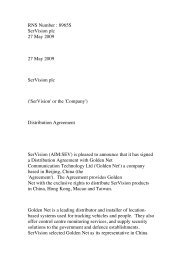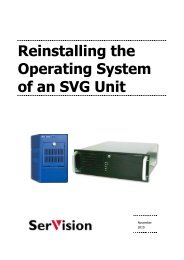TVG-Series System Guide v1-4 - SerVision
TVG-Series System Guide v1-4 - SerVision
TVG-Series System Guide v1-4 - SerVision
You also want an ePaper? Increase the reach of your titles
YUMPU automatically turns print PDFs into web optimized ePapers that Google loves.
<strong>SerVision</strong><br />
<strong>TVG</strong> <strong>System</strong> <strong>Guide</strong><br />
• Field<br />
Use<br />
Type<br />
• Description<br />
MVG and UVG:<br />
Select the network connection to use to connect to the DDNS server:<br />
• Any: The unit can use any available network connection; it will connect<br />
using the highest priority connection available (as defined under<br />
Network Priorities; see Network Priorities, page 51).<br />
• LAN: The unit will only use a LAN connection. If none is available, the unit<br />
will not connect to the DDNS server.<br />
• WiFi: The unit will only use a WiFi connection. If none is available, the unit<br />
will not connect to the DDNS server.<br />
• Modem: The unit will only use a Modem connection. If none is available,<br />
the unit will not connect to the DDNS server.<br />
HVG, CVG, CVG-M:<br />
Not currently in use.<br />
Select the type of DDNS service.<br />
Note: If you select No-IP or DynDNS, the Username, Password, and Confirm Password<br />
fields are added to the screen, and the Advanced field is removed from the screen.<br />
Hostname<br />
Fill in the hostname of the DDNS server.<br />
If you are using either No-IP or DynDNS, these values should have been supplied to you when<br />
you set up your account.<br />
If you are using the <strong>SerVision</strong> SV-DDNS service, the default hostname is the <strong>TVG</strong>'s default<br />
system name. This name is used when Use system name as hostname is selected. You<br />
can modify this name as you wish. To do so, clear the Use system name as hostname<br />
checkbox. A text field is added to the screen. Fill in the name you want to use. The name you<br />
choose should not include any spaces or underscores. In addition, you should make sure the<br />
name is unique. For example, you can include your name or the name of your company in the<br />
hostname to ensure it is unique. The complete hostname on the <strong>SerVision</strong> SV-DDNS server<br />
will be composed of the name you type plus .<strong>TVG</strong>.CC. For example, if you type<br />
“JaneSmytheOffice,” the hostname on the server is JaneSmytheOffice.<strong>TVG</strong>.CC.<br />
Note: Once DDNS is set up, changes to the server name will have no effect on the DDNS<br />
settings.<br />
4. If you are using either the No-IP or the DynDNS DDNS service, fill in the Username and Password fields.<br />
The username and password should have been supplied to you by No-IP or DynDNS when you set up your<br />
account there. Under Confirm Password, type the password a second time to ensure you typed it correctly.<br />
Note: <strong>SerVision</strong> cannot provide support for problems related to the No-IP or DynDNS DDNS services. For<br />
technical support, please contact the service providers.<br />
5. If you are using the SV-DDNS service and you want to change the address of the DDNS server, select<br />
Advanced. The fields required to specify the server are added to the screen.<br />
Configuring <strong>System</strong> Settings 56





